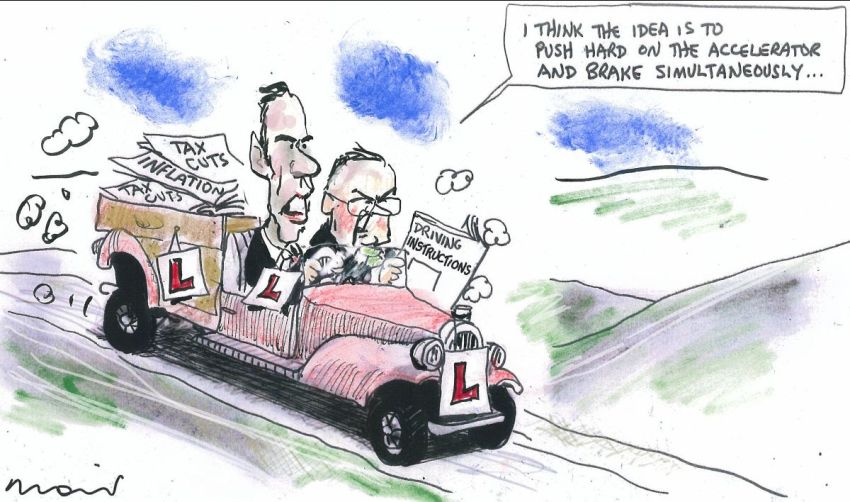
Calls to dump the federal government’s planned Stage 3 tax cuts are coming from many sectors: economists, unions, women’s groups, progressive think tanks and welfare groups.
Most objections are based on the regressive nature of the cuts: they will widen the gender pay gap and exacerbate women’s financial hardship; they will magnify inequality between rich and poor; and they are not affordable.
The Stage 3 tax cuts announced by Treasurer Scott Morrison in 2018 were designed to start from mid-2024. The cuts reduce the marginal rates of tax for those earning $45,000 all the way up to those on $200,000. They will disproportionately benefit those on higher incomes.
They will cause a $243 billion cut to the federal budget over the next 10 years.
Sue Bolton, Socialist Alliance candidate for the seat of Pascoe Vale in the Victorian elections, said the winners will include politicians, chief executives, company presidents and bank managers.
She called out Labor, which initially criticised, but then voted for the bill after the Coalition insisted they be voted for en bloc.
Bolton said Labor must reconsider. “Our public services, under huge strain, will not survive without the super rich paying their share. We need to tax the rich to address the crisis in acute health needs for First Nations people, violence against children and women and the necessary energy transition away from fossil fuels.”
Australian Council of Trade Union Secretary Sally McManus said in 2019 the stage 3 cuts “fundamentally changes the progressive nature of our tax system”. Why should the office cleaner and the CEO be in the same tax bracket, she asked?
For people on incomes of about $15,000 a year (around $300 a week) — the JobSeeker rate — paying $50 for anything other than food, transport, rent or energy is prohibitive. Seeing a doctor is not considered essential. For those earning $210,000 annually (around $4375 a week) spending $50 on anything is small change.
Power to Persuade, an independent platform for social policy discussion, said poorer households spend nearly 30% more on food as a percentage of overall expenditure than the highest income households, 26% more on housing, 72% more on utilities and 42% more on communications.
Conversely, these households spend 21% less on clothing and nearly 40% less on recreation.
That’s why a fair tax system needs to be progressive: it is based on the person’s ability to pay. If Labor continues with the Stage 3 cuts, the regressive tax system will become entrenched.
Some argue the Stage 3 tax cuts will lead to people spending more, which will lead to more jobs and a boosted economy.
But a boost to spending only happens when those on low incomes can afford to purchase more essentials, or buy items they could not previously afford.
High income earners tend to invest in shares, real estate or buy expensive imported goods, all of which do not boost economic activity in the domestic economy.
Shadow treasurer Jim Chalmers criticised the proposed tax cuts in 2019, asking how the Coalition would pay for the hole in the budget. “If [the Coalition government] want[s] to commit $95 billion five years out, they need to come clean on what services and programs they’ll cut in the budget to make room for it.”
Back then, he said the cuts would cost “roughly what we’re spending on aged care or public hospitals this year and more than what we’ll spend on the NDIS. “It’s roughly twice as much as we’ll spend on Newstart [now Job Seeker] or carers and childcare this year,” he claimed.
Chalmers was describing how governments have always remedied big deficits in their budgets: they cut spending on essential services, or they refuse to introduce improvements such as providing free childcare or raising single parent incomes or building more public housing.
Yet the Labor government is about to bring in Morrison’s Stage 3 tax cuts!
Such cuts will affect women more than men because women are still largely congregated in the lower-paid service and caring professions while the vast majority of high income earners are male.
An independent Parliamentary Budget Office (PBO) review, commissioned by the Australian Greens, found that men will take home nearly two-thirds of the benefit of the stage 3 tax plan between 2024–25 and 2032–33.
Greg Jericho, a policy director at the Centre for Future Work, reported on September 1 that the PBO report had found the top 1% of income earners, or those earning more than $180,000, will receive the same total benefit as the bottom 65% in 2024–25.
That’s a huge amount to go to just 3.7% of all income earners.
The stage 3 tax cuts are the opposite of what PM Anthony Albanese likes to claim Labor stands for — a fairer society.
Socialist Alliance stands for an end to the growing wealth divide and a progressive tax system that benefits the majority of working people and, in particular, disadvantaged groups.
[Mary Merkenich is a teacher unionist and member of Socialist Alliance.]